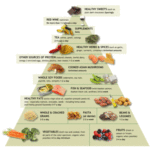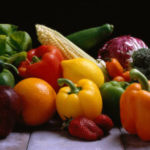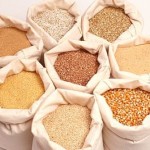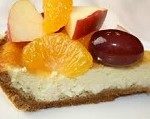Is Your Daily Diet ‘Clean’? – The Food Sensitive Shopper
Let’s Eat for Health & Longevity

Cartoon by Dan Berger
We hope you read our previous post ‘What is good, bad and necessary’. If you did you will know why we say to our Food Sensitive Shoppers to purchase ‘clean’ food. ‘Clean’ food has not been treated by excess chemicals for preservation, grown with neurotoxins like glycophates, organophosphates; been doused in ammonia; given rotten animal parts as food then antibiotics; or lived in animal waste until slaughter…you know this is the tip of the iceberg of harmful and inhumane practices in our food industry.
Today let’s forge a plan to create a daily diet that is as chemically free as possible with a typical budget and food intolerance.
For optimum health your food choices should include these foods (click on the photo to go to Dr. Weil’s website and a larger view):

Dr. Weil’s Anti-Inflammatory Pyramid
Did you notice there are few packaged foods in Dr. Weil’s anti-inflammatory food pyramid? Dr. Weil, M.D., has spent his professional lifetime committed to bridging healing with foods, herbs, vitamins, minerals, and lifestyle.
Your Food Sensitive Shopping List
We are assuming you will avoid any food your are allergic, intolerant, sensitive or opposed to eating:
1. Wild caught fish – If you cannot buy wild caught ask the fish monger about the farming practices. Natural health food stores and Whole Foods stock farm raised fish that have been sustainably raised without additives. Avoid any fish that says ‘color added’. ![]()

The Dirty Dozen and Clean 15 by PBS
2. Fruits and vegetables – If you cannot afford all organic fruits and vegetables click on the photo of the veggies for a list of safe non-organic produce. BTW, a diet rich in fruits and vegetables has been scientifically shown to help us live longer. 5 a day – eat them fresh, lightly steamed, or use very short cook time in the oven or microwave to prevent from too much nutrient loss.
Some must haves in your fruit and veggie drawers or freezer depending on the season and your food tolerance:
- Dark leafy greens like kale, spinach, dandelion greens, mustard greens, and dark lettuces
- Cruciferous vegetables like broccoli, brussel sprouts, and cauliflower
- Peppers of any kind
- Mushrooms (technically a fungus)- especially Shiitake and Portabella. Mushrooms are full of vitamin D
- Eggplant, zucchini, tomato, and onion
- Citrus
- Melons
- Pears and apples
- Berries
- Bananas
- and more…there are so many more delicious, nutritious fruits and veggies. Pick seasonal produce…this link will help you learn what fruits and veggies are in season – http://www.cuesa.org/eat-seasonally/charts/vegetables
3. Dairy products – milk, cheese, and yogurt – If your dairy is from a cow then choose organic. To save money drink and eat the proper serving size which is 6 ounces of yogurt, 8 ounces of milk or 2 ounces of cheese. 3 servings of dairy each day. Your body doesn’t need any more than that. Buy your cheeses fresh and, if possible, local. Avoid flavored dairy products since you don’t know the quality of the flavorings. Avoid RgBh (growth hormone), and antibiotics in milk products. 
Can’t afford organic cow’s milk? Try this… Purchase organic whole milk. Then when pouring an 8 ounce serving size fill the glass with 2/3 milk and 1/3 cold, fresh water. It creates low fat milk, provides your family with 50% more milk than if you purchased a container of low fat and saves money too.
For those of you who purchase non-dairy calcium enriched products look for the Non-GMO label, especially soy milk, to lessen the risk of exposure to any chemical or chemical compound.
4. Eggs – If you have a local egg farmer who allows her chickens to run free you have found the ‘golden’ egg…they are fresh! Fresh eggs have more nutrients.
Shopping for eggs? Look for ‘free range’ chickens. They don’t need to be organic or vegetarian. Vegetarian fed chickens are fed grain and may not roam free in a meadow or on grass…if they did they would eat bugs and worms which are not vegetarian. You want your chickens to be roaming so they eat lots of weeds, bugs, and worms for the best nutrient value. 
Local eggs are approximately 3.50 per dozen. One large egg is a serving size.
5. Meat / poultry – If you eat meat or poultry look for hormone free, antibiotic free, and non-GMO (including the feed). The most nutrients are found animal protein you can eat has a label that says ‘grass fed’ or ‘pasture raised’. 

On a budget? Eat the proper serving size – 4 ounces (size of the palm of your hand, i.e. a medium sized hand) per serving. Limit meat and/or poultry to 3 or less times per week.
6. Grain – Quinoa, brown rice, red rice, black rice, wheat berries, couscous, and whole millet are whole grains. Benefits are; the fiber aids digestion; nutrients like vitamin B. 
It is recommended to eat 6 to 10 servings per day of ‘whole grain‘. Serving size = 1/2 cup. Exercise occasionally? 6 servings are your target or less. Exercise regularly? 6 to 10 depending on intensity and how often…the more exercise the more servings you may need. Training every day? 10 servings
Flour isn’t a whole grain…it is ground and often stripped of necessary nutrients and fiber. Choose flours that were made with the entire grain intact. Examples: Whole wheat and brown rice flours
Budget friendly grains – bulk brown rice, quinoa, wheat berries and couscous. Cheaper and better for you than bread products.
7. Beans – An abundant and inexpensive staple eaten globally. These little fiber packed nuggets come in many varieties and can be made in variety of ways. They are low fat, full of fiber, and protein. This is a great ‘on the run food’ that can be made in a burrito (whole wheat tortilla), in a salad, or mixed with rice. Here’s a cool tip: beans and rice provide sustainable energy better than any protein bar. Pre-game meal – cooked beans, brown rice and one egg scrambled, poached or hard boiled. Add a favorite herb or spice (not salt) and you have a fiber and protein packed meal for sustainable energy at a low cost.
Beans need rinsing and soaking overnight for the best use in recipes. Serving – 4 to 6 ounces of cooked beans. 
8. Dessert – What is life without dessert? Recently celebrity chef Jaime Oliver acknowledged on The Colbert Report that desserts are cool, we want them but should eat them in moderation. But what is moderation? An example: a 2″ slice of pie or cake; one medium sized cookie, one small brownie, 1/2 cup of ice cream…not every day or at every meal.
We suggest desserts or any sugary food or beverage be limited to once or twice per week (depending on your health and physician’s recommendations) because your body DOES NOT need sugar…there is no recommended daily allowance for it. Sugar is related to a host of medical illnesses. 
What food pulls water from your muscles because it needs lots of water to be digested? Answer – SUGAR
Hmmm, then why would you want to drink a sports drink post game? Don’t these products have lots of sugar including corn syrup? You betcha!
Want to know how much food, i.e..calories, you need each day based on your activity level? You can calculate your intake at: http://www.mydailyintake.net/calculate-your-dis/
Our Food Sensitive Shopping list is complete. Time for a cool refreshment…how about WATER?…Cheers!
Janna
Category: Food
